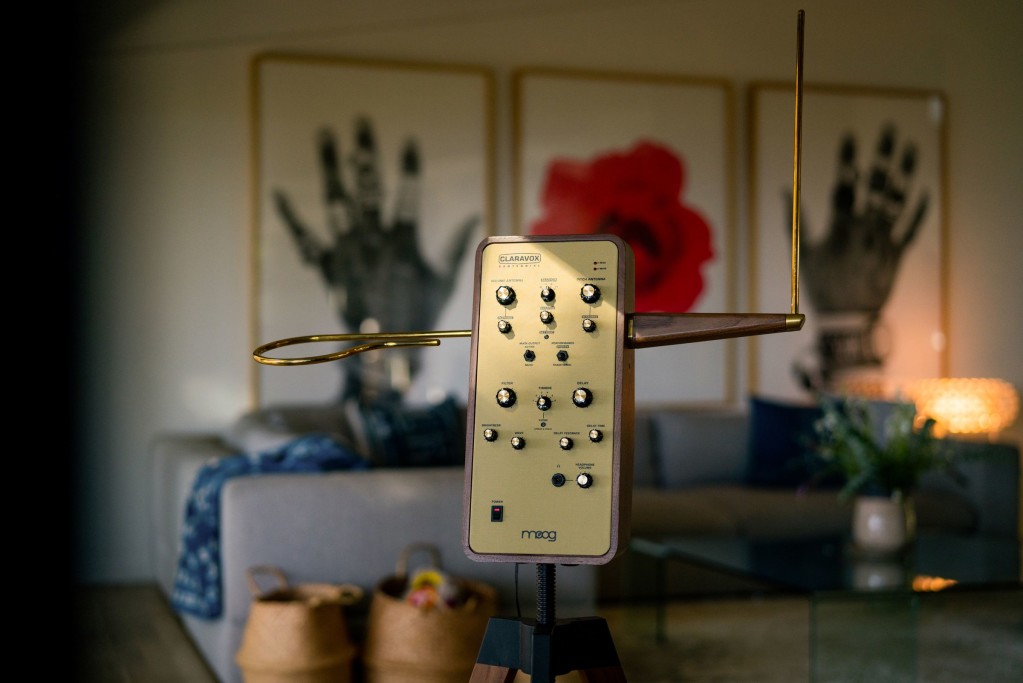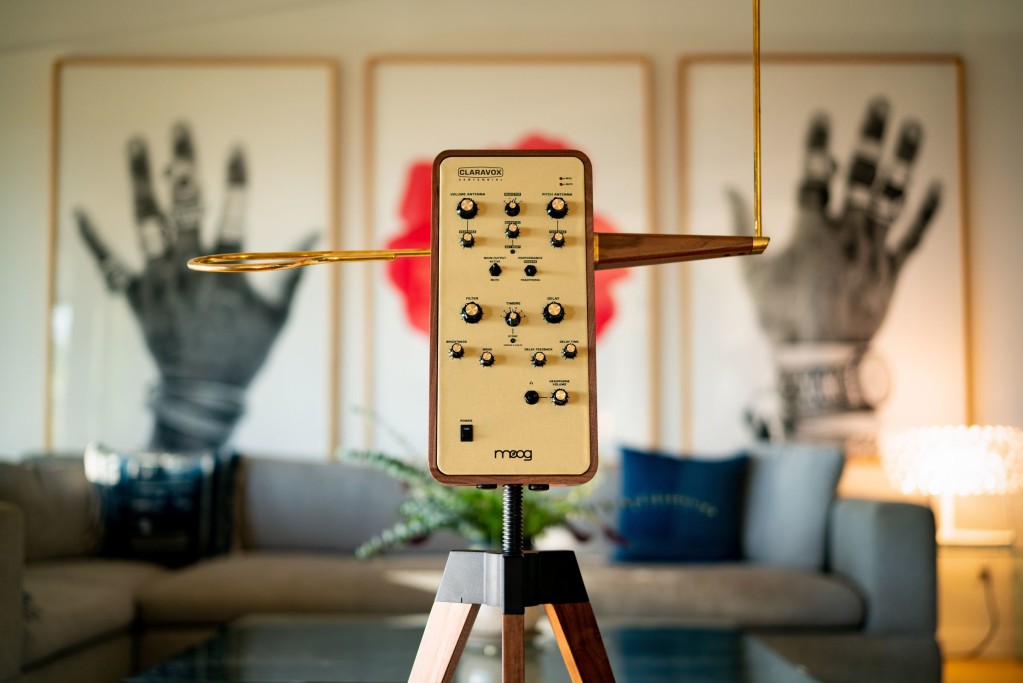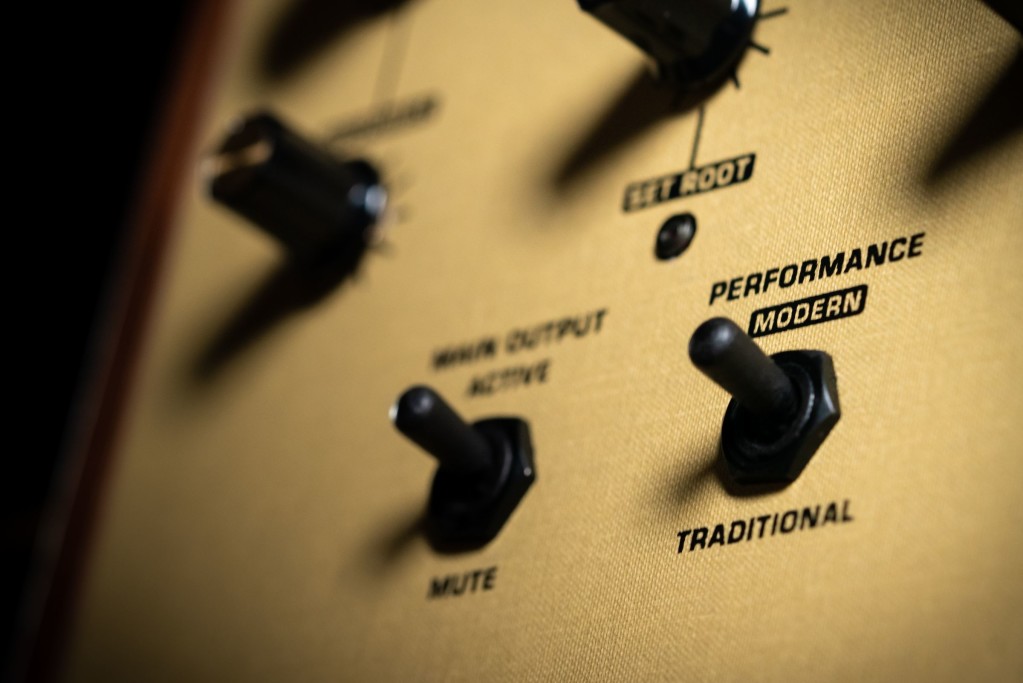The Theremin blew up 100 years of electronic musical instruments, so what better way to celebrate than honoring its grand diva, Clara Rockmore?
Once upon a time, the violin was maligned as an instrument. And so it is that advocates of the Theremin, even though it set the course of 20th century electronic music, still sometimes have to fight for its legitimacy. There’s also the simple fact that it’s hard to play (though so is a French Horn), or that it’s temperamental (though so is a harp). But as with all those instruments, the answer is in music. The folks at Moog Music today share this stunning performance by Grégoire Blanc of Debussy’s Claire de Lune, with pianist Orane Donnadieu.
This helps me to visualize owning the instrument, too, because of course I live at a baroque chateau surrounded by expansive gardens. You, too? Mon ami, rencontrons-nous et jouons ensemble à Theremin! Bien sûr!
Seriously, it’s gorgeous. So no more talk about sci-fi pulp or Halloween Theremin, please, or I’ll throw a bowl of candy corn at you.
The “Clara” in Claravox is of course Clara Rockmore. The Moog folks tell me they worked closely with the Nadia Reisenberg/Clara Rockmore Foundation, which since 2004 has worked to honor the legacy of these sisters. Born in Vilnius to a Lithuanian Jewish family (then in the Russian Empire, now modern Lithuania), they emigrated to the USA and together produced some of the great performances of the 20th century. And Clara Rockmore – well, she’s a story to herself, but of course, she is the greatest Theremin player ever to have lived, on the level of names like Niccolò Paganini, but on an electronic instrument.
http://nadiareisenberg-clararockmore.org/
Do watch her performance of Saint-Saëns. I’m not crying. Are you crying? Allergies.
I’ve listened to these performances on repeat, and emotions aside, tried to ask objectively if this instrument is special. But the gestures of hands in air allow expression and tone that’s somewhere between a violin and voice, yet somewhere in the ether. That interaction in physical space in electromagnetic analog is somehow organic. It’s demanding of preparation and intonation, but so is an acoustic instrument. Yet by not involving a bow or air or vocal cords, and letting the electronics do the singing, the nuances of the performance remain different. These pieces work as compositions on Theremin, and remain distinct instrumentation.
Hard to play? Well, here’s what Clara had to say about that:
Less is more, you can not treat air with hammers. You have to use delicate motions. You don’t even play with fingers. You have to play with butterfly wings.
The full story of the Theremin deserves a full telling, in any year and certainly in the centennial. But as far as Moog goes, it’s not an exaggeration to say that inventor Lev Termen unwittingly launched Bob Moog’s life path. The teen-aged Bob built his theremin from a plan published in Electronics World – it was (and is) an ideal starter project since the inner circuitry is simple. By 1954, Bob was working with his dad to build and sell instruments out of their Queens garage and published an expanded article in a journal called Radio & Television. (You can read that article and even build the plan inside – it’s intended to retain ease of construction while achieving greater operational stability. That’s a key to making a good Theremin – there are simple plans that also fail to work. Ahem.)
The Moog company claims Bob was instrumental in popularizing the instrument – about that, I’d have to consult some historians. I know my dad, with no particular electronics skill, built one (I think out of Popular Science). But what you can say is without a doubt, the business in making theremins led Bob to an interest in synthesizers and ultimately the creation of the Moog modular.
I think you can also say definitively that the endurance of the instrument in the United States is intertwined with Moog’s companies, including Big Briar (the precursor to today’s Moog Music).
What we have not had for a while is a new, proper Moog-built Theremin. Moog’s rock-solid Etherwave (and Etherwave Plus) variants are available, essentially what had been offered by Big Briar for decades. The Theremini was the one new entry, but it’s unlikely to please purists – it’s a digital instrument based on the Animoog engine . The company’s high-end offering – the sought-after Etherwave Pro – is discontinued. Do you need a bunch of extra features on a Theremin? Well, need, perhaps not, but the Etherwave Pro does genuinely expand the sonic range of the instrument and it looks the part if you land that big concert hall stage gig.

The Claravox is a high-end, premium, chateau-friendly instrument that’s both spiritually and technically descended from the Etherwave Pro. And the first thing you’ll find is that it’s simply beautiful – brass antennas, cloth-bound control panels, fine-grain walnut hardwood cabinet.
So even if you never touch one, let alone own one, the Claravox is a new ambassador to the classical music elite that announces that this is a serious instrument. Compared to those instruments, it’s not terribly expensive, either – US$1499, preorders now, shipping in December.
It’s without question the most synthesizer-like Theremin the Moog company has ever produced – but it also maxes out the company’s legacy in Theremin instruments. There’s the ability to use a dual oscillator/wavetable sound source with Theremin controls. There’s the rich waveshaping circuit from the Etherwave Pro – which retains onboard controls, something you can’t get from outboard gear. And if you miss tuning (you cheat!), there’s also the “modern” ability to add quantization and scales.
That is, the “hard to play” option is removed if you like. But if you demand the intonation of the original, it’s there. That seems reasonable, given there’s a limited population of Theremin players out there to buy something like this.

Also well worth noting is the inclusion of a signature Moog analog bucket brigade delay.
- Pitch Range: 5 octaves (Traditional Mode), 4-7 octaves (Modern Mode)
- Sound Sources: Analog Heterodyning Oscillator (Traditional Mode), Dual DCO/Wavetable Generator (Modern Mode) fed through Analog Waveshaping Circuit
- Theremin Controllers: Pitch and Volume, Waveshaper: Brightness, Wave, Filter, Switches for Mode and Mute, Analog Delay: Delay Amount, Delay Feedback, and Delay Time, Timbre: Timbre Select, Timbre Store.
- MODERN Mode only: Octave Range, Quantize Amount, Root/Scale Select, Pitch and Volume Response Curve
- Effects: Analog BBD Delay
- Preset storage: Yes
- Audio Outputs: 1 x 1/4″ (Main Out) , 1 x 1/4″ (Headphones), 1 x 1/4″ (Tuner Out)
- CV I/O: 2 x ¼” CV outputs, 2 x ¼” CV Inputs
- MIDI: In, Out, USB
- Materials: Brass Antenna, Walnut Wood Cabinet, Cloth-bound control paneling
- Power Source: DC power supply
- Mounting Options: Optional Moog Theremin Stand or Standard low-profile Mic Stand

After the guy whose name was Theremin, I can think of no one apart from Clara Rockmore more deserving of having a Theremin named after them.
Theremin reading, listening, watching
In honor of the occasion, Moog have also unloaded a treasure-trove of history, both regarding Bob Moog’s fascination with the instrument, and the origins of the Theremin invention and its impact on music.
The Theremin at 100: A Scrapbook of Thoughts (with author Albert Glinsky, who wrote Theremin: Ether Music and Espionage)
Electric Storm: 100 Years of Theremin A project by Composer Dorit Chrysler and filmmaker Marie Losier, with Theremin at the Large Hadron Collider
Love in the Ether (on Bob’s relationship with the instrument)
A Theremin Story feat. Clara Rockmore, Bob Moog, and Leon Theremin Interview with all three and music from Romeo Records, making a compelling new archival document
And of course that 1954 article
Chris Stack also sends us this 1991 super 8 video in which Bob talks about his take on the Theremin – and it’s clear that Leon Theremin is a hero to him:
Oh and – if it’s gotten a bit too snobby, all this business of playing Debussy in France, let’s talk about that Neil Armstrong Theremin connection they mention. Yes, it seems that Neil had a cassette copy along on Apollo 11 featuring the sultry 1947 Music Out of the Moon.
I feel the lady on the cover. This is exactly the position I find myself late at night in the studio now that our heat is fixed, once the music is really working. Dr. Samuel Hoffman Neil’s astronaut mates may have found the presence of the Theremin to be strange on the album, but I can’t imagine why – this is some of the most lush music I’ve ever heard for, uh, any instrument. It sounds like we’re heading to a moon palace where we’ll sip rich cocktails, peel ourselves some grapes, and gaze deeply into a lover’s eyes reclining in some uh… moon lounge?
It’s somewhat forgotten now, but Music Out of the Moon is kind of the Theremin’s Switched on Bach. Like Clara, too, Dr. Samuel Hoffman got his start on violin before taking up the Theremin. (That’s him on The Day the Earth Stood Still, too.) British composer Harry Revel was perhaps a good match for the Theremin, as he was the child of Russian immigrants – so some spirit of the Theremin in the blood. (Listen, too, to some of the more percussive Theremin entrants, as well as its sensuous melodies… a singer who also doesn’t have to breathe, appropriate to the lunar surface.)
And well, all this lounge exotica is the unmistakable touch of Les Baxter (who else?), but it sure does make an unexpected match for the Theremin.
There’s a high-quality digitized version – with equalization and a carefully-selected stylus, no less – available on Internet Archive. If someone at Capitol Records in fact still owns the rights and that wasn’t meant to happen, please don’t come after me. After all, I have some ex-KGB connections back in dear Moscow. Just sayin’.
https://archive.org/details/78_lunar-rhapsody_harry-revel-leslie-baxter_gbia0067207
Sorry. Something something 100 years of Theremin and Moog and … I got distracted.
But seriously, put on this album, and watch whatever you were meant to think about melt away. And tell me that Theremin purchase doesn’t start to sound totally priceless. Just wait for the Claravox Les Baxter Lounge Lizard Edition with martini shaker set and Moog-branded shag carpeting.
Fly me to the moon. Dear Maestro Termen, Clara, cheers.
https://www.moogmusic.com/products/claravox-centennial
More to celebrate 100 years of Theremin coming. Stay tuned.